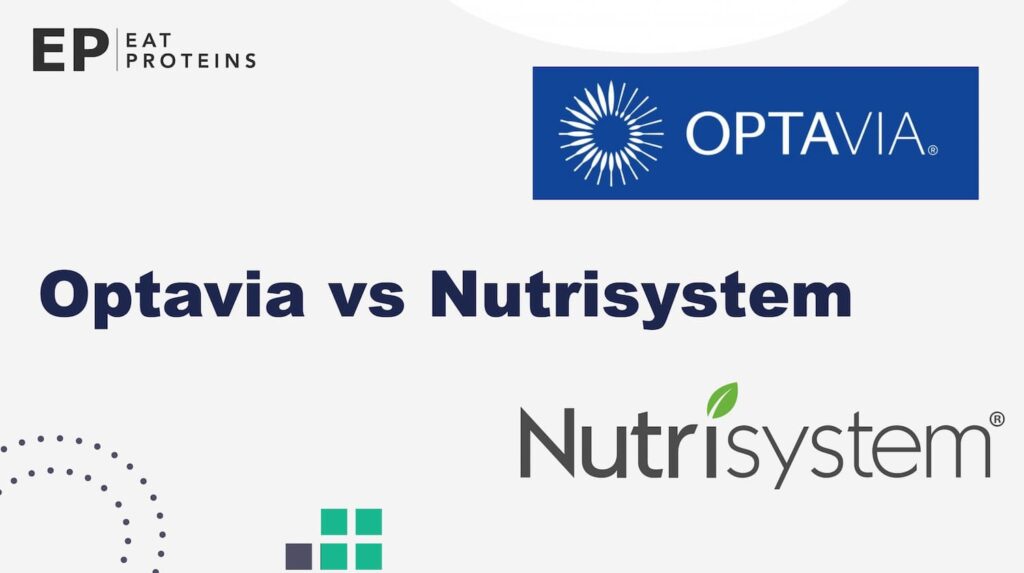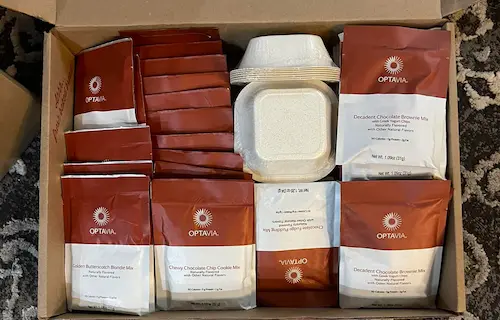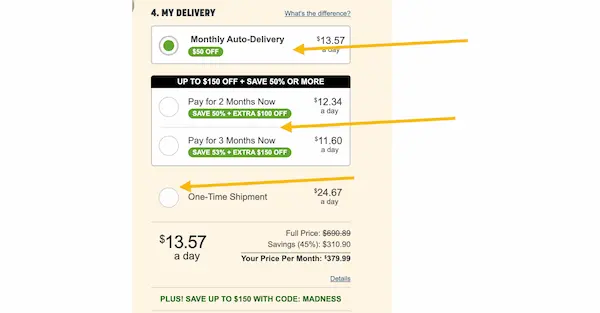
I’ve tested both Optavia and Nutrisystem, two renowned weight loss programs. They’re similar in that they handle meal preparation and offer meal replacements, which saves time. However, they can both be quite expensive. Optavia primarily provides shakes, bars, cereals, and desserts as meal replacements. All their options are calorie-controlled, but they require you to prepare one meal daily. In contrast, Nutrisystem delivers a full meal plan for 5 to 7 days, depending on your selected plan. Their menu features more traditional meal choices like ice cream, burgers, and pizza.
When comparing Nutrisystem with Optavia, I find myself leaning towards Nutrisystem because it is about 31.12% more affordable and offers a wider range of food choices. Although Nutrisystem charges extra for coaching, their coaches are trained in weight loss and nutrition, or have diploma education, providing a higher level of expertise than Optavia’s coaching.
That’s my overall comparison, but if you’re interested in the nitty-gritty details of how I compared Nutrisystem and Optavia in terms of prices, meal plans, products, calories, taste, weight loss results, and online reviews, keep reading.
What is the Optavia diet?
Optavia Diet is a weight loss program that helps shed extra pounds. It’s centered on eating low-calorie pre-packaged meals known as Optavia Fuelings, aiming to create a calorie deficit and kickstart fat-burning. Medifast, the parent company, defines Optavia as a holistic wellness program with four key components to help folks on their path to a healthier lifestyle. This photo shows what you receive when you get started and order the Optavia plan.

Optavia has three different types of programs to choose from. The difference lies in how many Optavia Fuelings you have each day and how many main meals you prepare. The most popular one is the Optavia 5 and 1 program, where you have five Optavia Fuelings and follow it up with one “lean and green” meal. Here’s a table that outlines the different Optavia plans:
| Plan | Description |
|---|---|
| Optimal Weight 5 & 1 Plan | Consists of five snacks (ready-to-eat or microwavable, around 500-550 calories total) plus one home-prepared Lean and Green meal. |
| Optimal Weight 4 & 2 Plan | Includes four Optavia Fuelings (about 400-440 calories), one extra snack, and two Lean and Green meals. |
| Optimal Health 3 & 3 Plan | Features three Optavia Fuelings (around 400-550 calories) and three balanced meals for health and nutrition maintenance. |
Optavia’s primary advantage is weight loss. A study conducted by Linda M. Arterburn in 2019 and published in Obesity Science & Practice revealed that individuals who stuck to the Optavia plan for 16 weeks achieved an impressive 5.7% reduction in body weight. Additionally, they saw a decrease in body fat and waist circumference compared to those who didn’t follow the program.
What is the Nutrisystem?
Nutrisystem offers pre-packaged meals and snacks for weight loss. Back in 1999, they shifted to selling their products online and via phone instead of physical centers. In a 2017 study by Chad M. Cook published in the Frontiers in Nutrition Journal, participants following the Nutrisystem plan for 16 weeks saw significant benefits like substantial weight loss, reduced fat mass, and improved body measurements. These results were notably better than those on a self-directed DASH diet. Here’s a photo of Nutrisystem’s Chocolate Brownie Sundae Cup, a 160-calorie snack with the taste of chocolate ice cream and 5 grams of protein per serving.

Nutrisystem’s meal count varies with the selected program. This table displays the three Nutrisystem meal plan tiers and their weekly meal counts.
| Nutrisystem plans | Number of meals | Menu |
|---|---|---|
| Basic | 5 days of meals (breakfast, lunch, dinner, and snacks) | Basic |
| Uniquely Yours | 5 days of meals (breakfast, lunch, dinner, and snacks) | Fancy |
| Uniquely Yours Max | 7 days of meals (breakfast, lunch, dinner, and snacks) | Fancy |
Optavia vs Nutrisystem: What’s the difference?
Nutrisystem and Optavia have key differences. Nutrisystem offers full meal delivery for 5 or 7 days, eliminating cooking and grocery shopping, while Optavia provides snacks but requires daily lean and green meal prep. In terms of getting started, Optavia involves enrolling with a coach, while Nutrisystem is simpler with online account setup and plan selection. Both offer various meal plans for different needs, including seniors, teens, diabetics, and nursing mothers. Other differences to consider between Nutrisystem and Optavia are cost, meal options, product variety, flavor, daily calories, and weight loss outcomes, along with customer feedback online.
Price
When it comes to Nutrisystem vs. Optavia in terms of cost, here’s the scoop: Nutrisystem is generally more budget-friendly, but only if you commit to their monthly auto-delivery subscription, which gives you a 50% discount. And, if you go month-to-month without auto-renewal, Nutrisystem’s cost is about 20% higher compared to Optavia. This photo shows the Nutrisystem website checkout page for the Max+ plan and the yellow arrows show auto-delivery options.

Here you see the most expensive Nutrisystem plan for Women is approximately $13.57 per day ($379.99/month) when you choose the auto-renewal option. If you decide to pay monthly without a subscription, the price goes up to $24.67 per day ($508.71/month). This table outlines the prices for different Nutrisystem plans:
| Plan | Price Per Day | Price Per Month |
|---|---|---|
| Nutrisystem Women’s Plan (Auto-Renewal) | $13.57 | $379.99 |
| Nutrisystem Women’s Plan (No Subscription) | $24.67 | $508.71 |
| Nutrisystem 3-Month Plan (Promotional Offer) | $7.97 | $239.09 |
When comparing Optavia and Nutrisystem prices, consider their pricing and bulk order options. Nutrisystem offers discounts for buying meals upfront for 2-3 months. For example, a 3-month plan was initially quoted at $1526.13, but with a promotion, I paid just $717.28 for three months, which is $239 per month.
Optavia’s price range falls on the higher side, typically ranging from $485.10 to $571.45 for their different plans. The cost of Optavia remains consistent, meaning they don’t often offer discounts or significant deals, except for a 23% discount for first-time buyers who subscribe to their Premier program. However, enrolling in Optavia Premier does come with additional perks, such as free shipping and a few one-time complimentary Fuelings.
Meal Plan
When comparing Optavia and Nutrisystem meal plans, one key difference is that Optavia’s top plan, the 5 and 1 plan, provides 5 Fuelings each day for a full 30 days, making it simple. However, you’ll need to prepare your own “lean and green” meal daily. On the other hand, Nutrisystem delivers all your meals for either 5 or 7 days, which is great if you prefer weekday meals delivered and cooking your own on weekends. If budget isn’t a concern and you want a full meal solution, consider combining Optavia Fuelings with a meal delivery service for your Lean and Green meals.
Products
When it comes to products, both Optavia and Nutrisystem offer meal replacements, but they vary. Optavia offers shakes, bars, and desserts, while Nutrisystem has a range of frozen breakfast, lunch, and dinner choices, totaling 136 meals. Keep in mind that most of Optavia’s Fuelings need preparation in the microwave or oven, and only their bars are ready to eat, but they have limited variety. On the other hand, Nutrisystem’s frozen meals include options like pizza, ravioli, and burrito bowls for lunch and dinner, along with breakfast choices like pancakes and oatmeal.
Taste
The taste difference between Optavia and Nutrisystem is significant. Optavia’s Fuelings are mainly powdered, but there are ways to make them more interesting by turning them into waffles, shakes, cupcakes, etc. Nutrisystem tastes slightly better, but it has small portion sizes, and some online reviews on Trustpilot suggest a decline in food quality in recent years.
Calorie intake
Optavia provides about 800-1,000 daily calories on the 5 and 1 plan, potentially leading to muscle loss, according to a 2017 study by Edda Cava from Washington University School of Medicine. Optavia Fuelings are around 100-110 calories each, and Lean and Green meals require 250-400 calories per meal. In contrast, Nutrisystem offers 1,200-1,500 calories for women and 1,500-1,800 calories for men, which Dr. Cava suggests is more sustainable long-term without muscle loss. Nutrisystem lunches and dinners are about 230-250 calories, and snacks are 120-130 calories.
Weight Loss
Optavia and Nutrisystem had varying results for my weight loss journey. With Optavia, I lost over 40 pounds in 12 months, reducing my BMI from 37 to 29 by incorporating proteins and vegetables. However, I regained weight due to mistakes and an unhealthy food relationship. Nutrisystem provided results, but the food was less satisfying, making me occasionally hungry. Optavia suits those comfortable with sachets and low-carb dinners, while Nutrisystem offers a simpler meal plan for those averse to calorie counting and extensive cooking. Your choice depends on preferences and goals.
Coaching
Both Nutrisystem and Optavia offer one-on-one coaching, which greatly impacts weight loss results. A 2018 study by Stefanie Lynn Painter in the Journal of Medical Internet Research showed that active participation in coaching sessions and receiving food log feedback from experts significantly contributed to weight loss. However, it’s crucial to note that Optavia’s coaching, although free, is handled by sales representatives lacking nutrition expertise. In contrast, Nutrisystem provides coaching at an additional cost, but you’ll have the advantage of working with certified nutrition experts like dietitians and nutritionists, offering more reliable guidance.
Side effects
Both Nutrisystem and Optavia have potential side effects, which can vary among individuals. Nutrisystem relies on low-calorie processed meals, possibly causing hunger, lower energy, and digestive discomfort, especially if you’re used to whole foods. On the other hand, Optavia’s Fuelings aims for mild ketosis, leading to potential headaches, bad breath, and constipation. If you’re sensitive or have a history of disordered eating, consult your doctor before choosing either. Just like I did before starting my program, I recommend you do the same.
Who comes out on top of Optavia versus Nutrisystem?
Nutrisystem wins over Optavia due to its lower cost, wider meal variety, and ongoing discounts. In my opinion, while Optavia offers convenient pre-packaged meals and potential weight loss benefits, it also relies heavily on processed foods, can lead to side effects like constipation and bad breath, and requires preparing “lean and green” meals. On the other hand, Nutrisystem offers meal variety and delivery convenience but might have smaller portions, decreasing food quality in some user reviews, and potential side effects like hunger and digestive issues.
What are the alternative diets to Nutrisystem and Optavia?
The alternative diets to Optavia and Nutrisystem are plentiful. If you’re seeking a more holistic approach, consider the DASH diet or Mediterranean diet. If you’re interested in diets like Optavia that provide meal solutions, I recommend exploring Jenny Craig, Ideal Protein, or the Skinny Box diet. For something in between, combining cooking with meal replacements, you might want to try the Slimfast diet or Wonderslim diet.
How do Nutrisystem and Optavia compare to the GOLO diet?
Optavia, Nutrisystem, and the GOLO diet all aim for weight loss, but they differ significantly in their approaches: Optavia offers pre-packaged meals and one-on-one coaching, Nutrisystem focuses on convenient meal delivery, and the GOLO diet emphasizes managing insulin resistance through whole foods and GOLO Release supplements. While GOLO and Nutrisystem both provide comprehensive meal plans, GOLO diverges by incorporating a proprietary supplement and does not operate under an MLM model.

